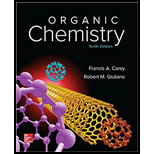
ORGANIC CHEMISTRY (LOOSELEAF)-PACKAGE
10th Edition
ISBN: 9781260008562
Author: Carey
Publisher: MCG
expand_more
expand_more
format_list_bulleted
Concept explainers
Question
Chapter 11.3, Problem 8P
Interpretation Introduction
Interpretation:
The equations for the propagation steps in the formation of
Concept Introduction:
>Allylicbromination occurs such that the bromine gets attached to the allylic carbon atom.
>The reaction proceeds through initiation, propagation, and termination steps.
>During propagation, new free radicals are generated in each step.
Expert Solution & Answer
Want to see the full answer?
Check out a sample textbook solution
Students have asked these similar questions
In the following reaction, the OH- acts as which of these?
NO2-(aq) + H2O(l) ⇌ OH-(aq) + HNO2(aq)
Using spectra attached, can the unknown be predicted? Draw the predicition. Please explain and provide steps.
Molecular focrmula:C16H13ClO
Calculate the percent ionization for 0.0025 M phenol. Use the assumption to find [H3O+] first. K = 1.0 x 10-10
Chapter 11 Solutions
ORGANIC CHEMISTRY (LOOSELEAF)-PACKAGE
Ch. 11.1 - Prob. 1PCh. 11.1 - Prob. 2PCh. 11.2 - The two compounds shown differ by a factor of 60...Ch. 11.2 - Prob. 4PCh. 11.2 - Prob. 5PCh. 11.2 - Prob. 6PCh. 11.3 - Prob. 7PCh. 11.3 - Prob. 8PCh. 11.3 - Evaluate 2,3,3-trimethyl-1-butene as a candidate...Ch. 11.4 - After heating a solution of allyl tert-butyl...
Ch. 11.5 - Prob. 11PCh. 11.6 - Prob. 12PCh. 11.8 - Prob. 13PCh. 11.9 - What dienes containing isolated double bonds are...Ch. 11.10 - Prob. 15PCh. 11.10 - Prob. 16PCh. 11.11 - Prob. 17PCh. 11.12 - Dicarbonyl compounds such as quinones are reactive...Ch. 11.12 - 2,3-Di-tert-butyl-1,3-butadiene is extremely...Ch. 11.12 - Methyl acrylate (H2C=CHCO2CH3) reacts with...Ch. 11.13 - Prob. 21PCh. 11.14 - What diene and dienophile could you use to prepare...Ch. 11.14 - Write equations in the synthetic direction for the...Ch. 11.16 - Prob. 24PCh. 11.16 - Prob. 25PCh. 11 - Write structural formulas for each of the...Ch. 11 - Give an acceptable IUPAC name for each of the...Ch. 11 - A certain species of grasshopper secretes an...Ch. 11 - Which of the following are chiral?...Ch. 11 - Describe the molecular geometry expected for...Ch. 11 - Prob. 31PCh. 11 - What compound of molecular formula C6H10 gives...Ch. 11 - Prob. 33PCh. 11 - Prob. 34PCh. 11 - Prob. 35PCh. 11 - Prob. 36PCh. 11 - Identify the more reactive dienophile in each of...Ch. 11 - Prob. 38PCh. 11 - Prob. 39PCh. 11 - Prob. 40PCh. 11 - Prob. 41PCh. 11 - Prob. 42PCh. 11 - Prob. 43PCh. 11 - Prob. 44PCh. 11 - Prob. 45PCh. 11 - Prob. 46PCh. 11 - Show how to prepare each of the following...Ch. 11 - Prob. 48PCh. 11 - Prob. 49PCh. 11 - Prob. 50PCh. 11 - Compound A was converted to compound B by the...Ch. 11 - Suggest reasonable explanations for each of the...Ch. 11 - Prob. 53PCh. 11 - Prob. 54PCh. 11 - Prob. 55DSPCh. 11 - Prob. 56DSPCh. 11 - Prob. 57DSPCh. 11 - Prob. 58DSPCh. 11 - Prob. 59DSP
Knowledge Booster
Learn more about
Need a deep-dive on the concept behind this application? Look no further. Learn more about this topic, chemistry and related others by exploring similar questions and additional content below.Similar questions
- The Ka for sodium dihydrogen phosphate is 6.32 x 10-8. Find the pH of a buffer made from 0.15 M H2PO4- and 0.25 M HPO42- .arrow_forwardThe Ka for lactic acid is 1.4 x 10-4. Find the pH of a buffer made from 0.066 M lactic acid and 0.088 M sodium lactate.arrow_forwardZaitsev's Rule 3) (a) Rank the following alkenes in order of decreasing stability. most stable A B C D > > > (b) Rank the following carbocations in order of decreasing stability least stable B C Darrow_forward
- Calculate the percent ionization for 0.35 M nitrous acid. Use the assumption to find [H3O+] first. K = 7.1 x 10-4arrow_forwardFor each of the following reactions: Fill in the missing reactant, reagent, or product (s), indicating stereochemistry where appropriate using dashed and wedged bonds. If the reaction forms a racemic mixture, draw both structures in the box and write the word “racemic”.arrow_forward5) Using the carbon-containing starting material(s), propose a synthesis based on the following retrosynthetic analysis. Provide structures for all intermediates. The carbon atoms in the product must originate from the starting material(s), but you may use as many equivalents of each starting material as you would like, and any reagent/reaction you know (note: no mechanisms are required). H H =arrow_forward
- Calculate the percent ionization for 0.0025 M phenol. Use the assumption to find [H3O+] first. K = 1.0 x 10-10arrow_forward10:04 AM Tue Mar 25 Sunday 9:30 AM 95% Edit Draw the corresponding structures in each of the boxes below: Ester Name Methyl butyrate (Example) Alcohol Structure H3C-OH Acid Structure Ester Structure Isoamyl acetate Ethyl butyrate Propyl acetate Methyl salicylate Octyl acetate Isobutyl propionate Benzyl butyrate Benzyl acetate Ethyl acetate H₂C OH HCarrow_forward2) For each of the following reactions: (i) (ii) Fill in the missing reactant, reagent, or product (s), indicating stereochemistry where appropriate using dashed and wedged bonds. If the reaction forms a racemic mixture, draw both structures in the box and write the word "racemic". (a) (b) 1) R₂BH 2) H₂O2, NaOH (aq) HBr Br racemic Br + Br Br racemicarrow_forward
arrow_back_ios
SEE MORE QUESTIONS
arrow_forward_ios
Recommended textbooks for you
 EBK A SMALL SCALE APPROACH TO ORGANIC LChemistryISBN:9781305446021Author:LampmanPublisher:CENGAGE LEARNING - CONSIGNMENT
EBK A SMALL SCALE APPROACH TO ORGANIC LChemistryISBN:9781305446021Author:LampmanPublisher:CENGAGE LEARNING - CONSIGNMENT Organic ChemistryChemistryISBN:9781305580350Author:William H. Brown, Brent L. Iverson, Eric Anslyn, Christopher S. FootePublisher:Cengage Learning
Organic ChemistryChemistryISBN:9781305580350Author:William H. Brown, Brent L. Iverson, Eric Anslyn, Christopher S. FootePublisher:Cengage Learning

EBK A SMALL SCALE APPROACH TO ORGANIC L
Chemistry
ISBN:9781305446021
Author:Lampman
Publisher:CENGAGE LEARNING - CONSIGNMENT

Organic Chemistry
Chemistry
ISBN:9781305580350
Author:William H. Brown, Brent L. Iverson, Eric Anslyn, Christopher S. Foote
Publisher:Cengage Learning
